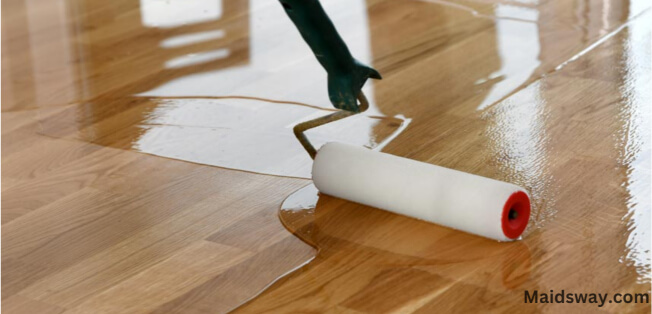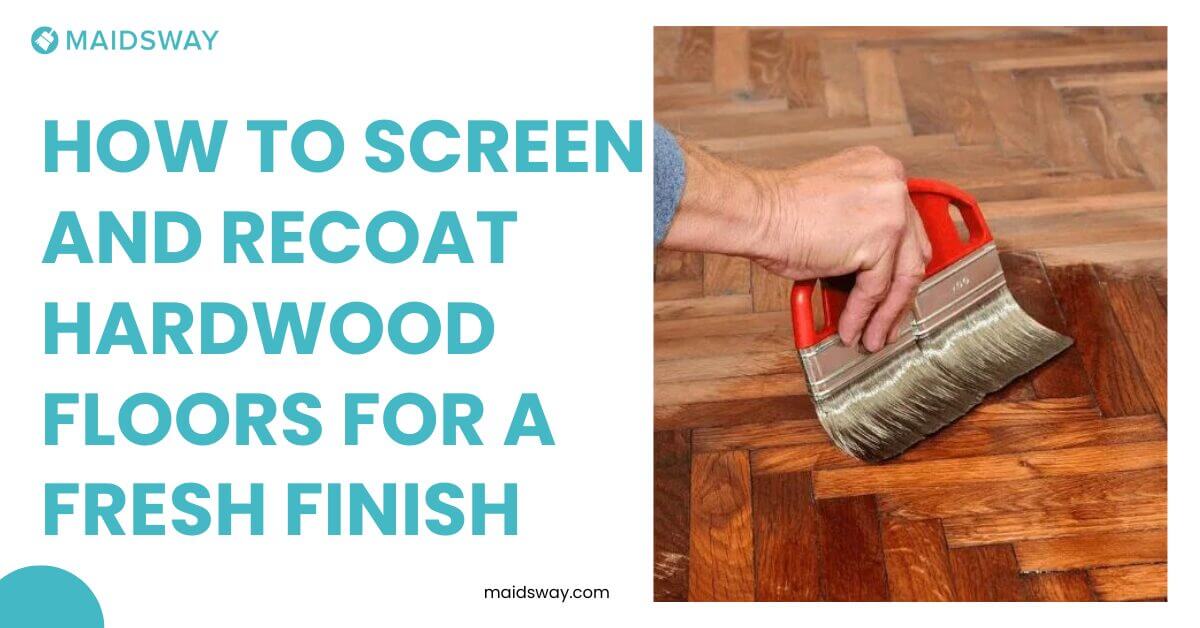Hardwood floors are a classic choice for house interiors, combining durability and elegance. However, wear and tear can degrade the finish, making it appear lifeless. The good news is that restoring their beauty does not necessarily require extensive sanding and refinishing.
In this guide on How to Screen and Recoat Hardwood Floors, I’ll walk you through an easy and effective technique to refresh your floors’ appearance without the need for a major renovation.
Recognizing the Need for Screening and Recoating
Before choosing a screening and recoating process, you should assess the state of your hardwood floors. This procedure is ideal for floors with surface scratches or slight wear and tear but still have a firm finish. If the floor has deep gouges or the finish has worn through to the wood, thorough sanding may be required. These are the key signs you should screen and recoat:
- Light surface scrapes or scuffs.
- Dull finish with no exposing of bare wood.
- No major water damage or discoloration.
Preparing for the Screening and Recoating process
Preparation is essential for attaining optimal results. Before you screen and recoat hardwood floors, ensure the room is completely free of furniture and other obstacles.
Steps for preparation:
- Clean the floor thoroughly: Remove dust and dirt by sweeping or vacuuming. To remove any remaining residue, apply a hardwood floor cleaner.
- Inspect for damage: Before screening wood floors, secure loose boards or nails and fix any minor cracks or holes with wood filler.
Choosing the Right Tools for Screening and Recoating
To screen the floor and prepare it for recoating, you will need specific tools:
- Floor buffer with sanding screen: This is the primary instrument for screening hardwood floors. The sanding screen rubs the surface lightly, removing the top finish layer without sanding down to the wood.
- Vacuum and tack cloths: These are used to remove dust after screening.
- Applicator pads or brushes: These are used to apply a new finish coat.
- High-quality polyurethane finish: It is available in oil- and water-based varieties, depending on your preference.
How to Screen Hardwood Floors?
Screening lightly sands the floor’s surface to remove gloss and prepare it for the fresh coat. It’s a gentler process than full sanding, but ensuring the new finish adheres properly is essential.
Steps to Screen Hardwood Floors:
- Attach the sanding screen to the buffer; use a 120-grit screen for the best results.
- Run the buffer across the entire floor. Move gently and steadily to achieve even abrasion across the surface. Be sure to screen the floor in small pieces.
- Vacuum the floor thoroughly. Remove any dust formed during the screening procedure.
- Wipe down with a tack cloth to remove any remaining dust or dirt, leaving a clean surface for recoating.
How to Clean Hardwood Floors After Screening?
After screening, ensure the floor is clean before applying the new finish. Leftover dust or particles can interfere with recoating, resulting in flaws.
Cleaning steps:
- Vacuum: Use a vacuum with a soft brush attachment to remove any leftover dust from the screening.
- Tack Cloth: Use a tack cloth to remove tiny particles and keep the floor dust-free.
How to Recoat Hardwood Floors After Screening?
Now that the floor has been prepared and cleaned, you may apply the new finish. Recoating hardwood floors entails applying a new layer of polyurethane to maintain and restore the floor’s sheen.
- Choose the Finish: Choose between oil and water-based polyurethane. Oil-based finishes create a rich, warm tone, while water-based finishes are clearer and dry faster.
- Apply the finish: Use an applicator pad or brush to apply a thin, even coat of polyurethane. Start in a corner and work your way out to avoid treading on the damp floor.
- Allow drying time: Follow the manufacturer’s directions for drying time. Water-based finishes dry quickly (usually 2-4 hours), whereas oil-based finishes might take up to 24 hours.
- Apply additional coats if needed: For optimal protection, apply 2-3 coats of polyurethane, allowing each coat to dry fully between applications.

Essential Tips for Long-Term Floor Care
Now that your hardwood floors have a fresh new finish, appropriate upkeep is essential to keep them looking great for years.
Long-term Care Tips:
- Use area rugs in high-traffic areas to reduce wear and tear.
- Sweep or vacuum frequently to keep dust and debris from scratching the surface.
- Avoid harsh chemicals, and use cleaning products developed for them to protect the finish of your hardwood floors.
- Place felt pads on the bottoms of furniture legs to prevent scratches when moving goods.
Conclusion
Knowing how to screen and recoat hardwood floors will help them last longer and look great for years. Screening hardwood floors is less invasive than full sanding, yet the results are still good. With the correct equipment and procedures, you can breathe new life into your floors and keep them shiny with regular maintenance.
FAQs
1- What is screening and recoating hardwood floors?
Screening involves lightly sanding the floor's surface, while recoating adds a new protective finish. This process restores shine without full sanding.
2- How often should I screen and recoat hardwood floors?
Most floors benefit from screening and recoating every 3-5 years, depending on wear and traffic levels.
3- Can I use water-based or oil-based polyurethane for recoating?
Both are effective. Water-based dries faster and is clear, while oil-based gives a rich, amber tone and is more durable.
4- How long does it take to recoat hardwood floors?
Each coat of finish takes 2-4 hours to dry for water-based and up to 24 hours for oil-based finishes. Plan for multiple coats if needed.

